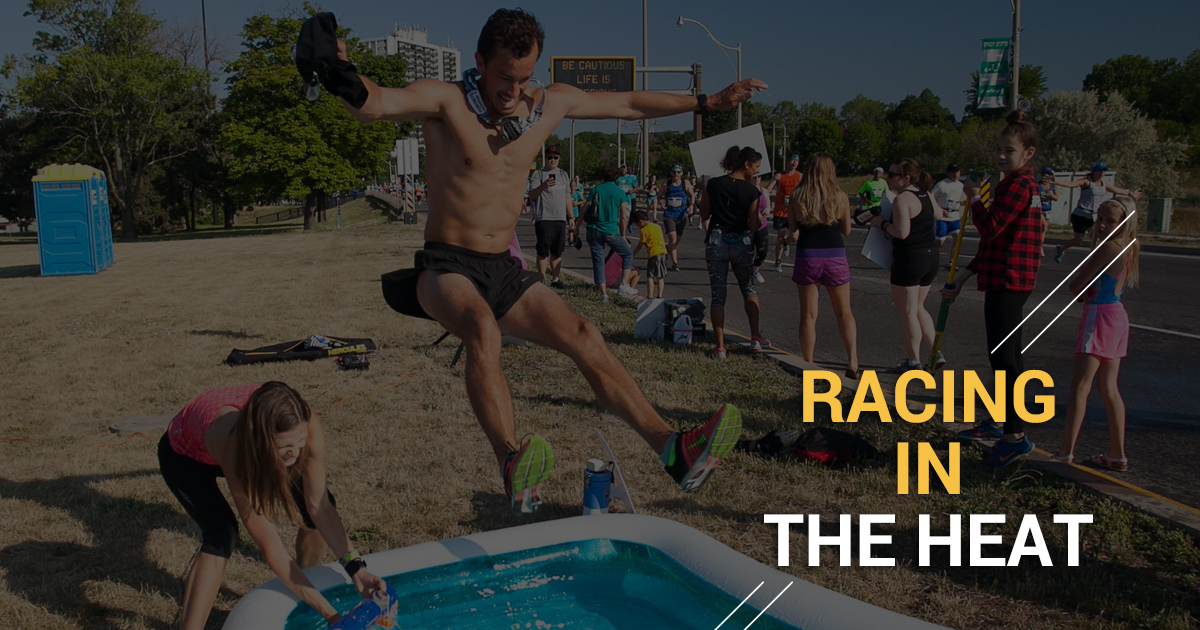
The weather is the most unpredictable part of race day. You have no control over the conditions, and they can change overnight depending on what Mother Nature wants to throw at us. Not only does the weather on race day matter, but the weather in which you’ve done your training will determine how much you’re affected by race day conditions. If it’s been a cold winter and spring, and your target race ends up being in scorching heat, the body is in for a shock! Here are a few things that you can do to help make your race day as ideal as possible:
Layer up
As acclimation doesn’t happen instantly when the temperature warms up, you can use your final weeks before the race for mock heat training. This doesn’t mean trying to wrestle a treadmill into a sauna and running for hours. Full acclimatization takes about 10-14 days so an easy way to get ready for the heat is to wear an extra layer on your runs. You can wear tights over shorts and a long sleeve over a singlet to get your body slightly more adapted to hotter conditions. Don’t forget to increase your fluid intake before/during/after to ensure you don’t risk dehydration from higher sweat loss rates.
Arrive early
If your target race is out of town, try to arrive to the destination a few days in advance. Just one or two days of acclimation can make a big difference come race day. Doing a shakeout run and being in the heat for a few days will not only give you an idea of what to expect on race day, it’ll help prepare your body to better withstand the heat.
Focus on hydration/nutrition
Running in the heat increases your sweat production in order to dissipate heat and regulate your core temperature. When your sweat rate increases, it decreases your blood volume. This is due to a reduction in the body’s total fluid volume if you’re not adequately replenishing. Maintaining a normal blood volume is essential as your muscles need blood flow and oxygen delivery in order to work effectively. However, try not to just drink water. Consume electrolytes and carbohydrates to help to keep your internal electrolyte balance stable. Use the classic pee test to monitor your hydration. Aim for a light yellow urine colour which indicates you’re hydrated but not diluted.
In terms of nutrition, the fuels you ingested in cooler climates may not sit as well in your gut when the weather heats up. Practice taking in fluid and fuel as much as you can in hotter conditions to know exactly what you’ll be able to take in on race day. On the big day, equip yourself with the fuel you need, and be sure to drink early and often while on course.
Protect your body
Apply sunscreen of at least SPF 30 on any visible skin, including scalp, ears, and back of the neck, to protect it from the sun’s harmful UV rays. But don’t just rely on sunscreen to protect you. Wear a hat or visor, sunglasses, light-coloured and loose-fitting clothing. The light colour will reflect the heat, and a loose fit will help to let the air circulate and cool your body down.
Start cool
If there’s a chance that you’re able to reduce your core temperature before the race starts, do it. Whether it’s consuming icy drinks, placing an ice bandana around the back of your neck, or wearing a fancy ice vest, use a method that’s accessible to you. Being comfortably cool at the start of the race means you’ll take longer to get up to a level of overheating. Ice on the back of the neck is a great option because when the ice melts, the cool water will trickle down your back and continue to keep you cool.
Set appropriate expectations
When coming into a hot race, understand that the temperature is going to affect the pace you’re able to hold for the duration of the race. If you were shooting for a PB, think about setting that goal to the side if race day is going to be a scorcher. Don’t underestimate the power of perceived exertion. Listen to your body over the splits that are displayed on your watch.
If your body is rebelling against the heat, reset and focus on the race as an experience and enjoy it. If a personal best, or your A-goal isn’t attainable, weigh the pros/cons of finishing the race or deferring the effort to a subsequent race. If stepping off the course is going to reduce your risk of injury and allow you to try again at a different race, it could be worth it. Here is a chart that’s worth noting when trying to decide what to do:
| DEW POINT (°F) | RUNNER’S PERCEPTION | HOW TO HANDLE |
| 50–54 | Very comfortable | PR conditions |
| 55–59 | Comfortable | Hard efforts likely not affected |
| 60–64 | Uncomfortable for some people | Expect race times to be slower than in optimal conditions |
| 65–69 | Uncomfortable for most people | Easy training runs might feel OK but difficult to race well or do hard efforts |
| 70–74 | Very humid and uncomfortable | Expect pace to suffer greatly |
| 75 or greater | Extremely oppressive | Skip it or dramatically alter goal |







